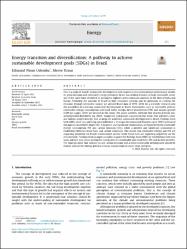| dc.contributor.author | Udemba, Edmund Ntom | |
| dc.contributor.author | Tosun, Merve | |
| dc.date.accessioned | 2022-10-24T07:32:33Z | |
| dc.date.available | 2022-10-24T07:32:33Z | |
| dc.date.issued | 2022 | en_US |
| dc.identifier.issn | 0360-5442 | |
| dc.identifier.uri | https://hdl.handle.net/11363/3725 | |
| dc.description.abstract | This is a study of Brazil's sustainable development with respect to its environmental performance amidst
its great emission and renewable energy potentials. Brazil has striking features of large renewable sector
and at the same time identified as among the highest carbon emission countries in the likes of India and
Russia. Following the position of Brazil in both emissions ranking and its potentials in curbing the
emission through renewable source, we utilized Brazil data of 1970e2018 for a scientific research into
the possibility of achieving sustainable development in Brazil. Instruments such as renewable policies
(renewable energy consumption and fossil fuels), foreign direct investments (FDI) and income growth
(GDP per capita, 2010) are utilized in this study. We adopt scientific methods like structural break test,
autoregressive distributed lag (ARDL) bound test and granger causality in this study. This will give a clear
and holistic insight into the best strategy for achieving sustainable development in Brazil. Findings from
both ARDL short run and long run established a U-shape environmental Kuznets curve (EKC) instead of
the popular inverted U-shape EKC. A negative and significant relationships are found between renewable
energy consumption, FDI and carbon emission (CO2), while a positive and significant association is
established between fossil fuels and carbon emissions. This points that renewable energy and FDI are
impacting positively on Brazil's environment quality while fossil fuels are impacting negatively on the
environment. Findings from granger causality support the findings from ARDL by establishing both two
ways and one way nexus among the energy policies (renewable and fossil fuels, FDI and income growth).
The findings show that policies to curb carbon emission and achieve sustainable development should be framed around the energy policies (energy transmission to more clean energies). | en_US |
| dc.language.iso | eng | en_US |
| dc.publisher | Elsevier | en_US |
| dc.relation.isversionof | https://doi.org/10.1016/j.energy.2021.122199 | en_US |
| dc.rights | info:eu-repo/semantics/openAccess | en_US |
| dc.rights | Attribution-NonCommercial-NoDerivs 3.0 United States | * |
| dc.rights.uri | http://creativecommons.org/licenses/by-nc-nd/3.0/us/ | * |
| dc.subject | Renewable Energy | en_US |
| dc.subject | Fossil fuels | en_US |
| dc.subject | FDI | en_US |
| dc.subject | Income growth | en_US |
| dc.subject | ARDL | en_US |
| dc.subject | Brazil sustainability | en_US |
| dc.title | Energy transition and diversification: A pathway to achieve sustainable development goals (SDGs) in Brazil | en_US |
| dc.type | article | en_US |
| dc.relation.ispartof | Energy | en_US |
| dc.department | İktisadi İdari ve Sosyal Bilimler Fakültesi | en_US |
| dc.identifier.volume | 239 | en_US |
| dc.identifier.issue | 122199 | en_US |
| dc.identifier.startpage | 1 | en_US |
| dc.identifier.endpage | 9 | en_US |
| dc.relation.publicationcategory | Makale - Uluslararası Hakemli Dergi - Kurum Öğretim Elemanı | en_US |



















